How to make a node of the passage of ventilation through the roof: arrangement of roofing penetration
To bring the chimney to the roof - this task at first glance does not seem particularly difficult. But in practice, everything is much more complicated: the node of the passage of ventilation through the roof should be performed very carefully and in compliance with all technical requirements. After all, the integrity of the roofing pie should be maintained and tightness ensured.
We will tell you how to install roofing in accordance with building codes. In the article we presented, two options are analyzed: for a hard and soft type of coating. Based on our tips, you can perfectly do the work yourself.
The content of the article:
Passage requirements
Of course, in a place where a ventilation pipe or any other pipe passes through the roof, it is necessary to ensure sufficient tightness so that moisture does not enter the building. At the same time, this unit should not impede the precipitation from the roof surface. Another important point is the availability of reliable thermal insulation.
The top of the pipe should be protected from moisture by a deflector. There are certain requirements for the length of the ventilation pipe, designed to provide sufficient traction inside the structure, although they are not as strict as the norms for chimneys.
Often, air exchange through ventilation is provided by force, using an exhaust fan, which is also installed near the junction. This mechanism should also be reliably protected from the effects of precipitation and other natural factors. In addition, it is mandatory to provide grounding of the appliance.
Incorrect installation of this unit often leads to poor removal of precipitation from the surface, which can lead to early damage to the roofing material. A lot of trouble can cause the ventilation duct of an apartment building if it goes to the roof across a ramp.
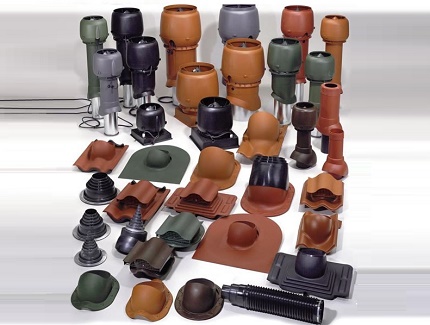
It is much better if the site is located along the ramp, so it will create fewer obstacles for water to drain. The optimal position is the location of a large transition node along the ridge. This option eliminates the need to install additional elements that reduce the resistance of the ventilation pipe to convergence of precipitation.
A serious installation error is considered to be the situation in which the front apron is under the roofing sheet. An apron is a design that provides a tight fit of the roof to the walls of the pipe. If the lower part of the apron is brought under the roof, water will drain into the gap, falling into the roofing cake and then into the attic space.
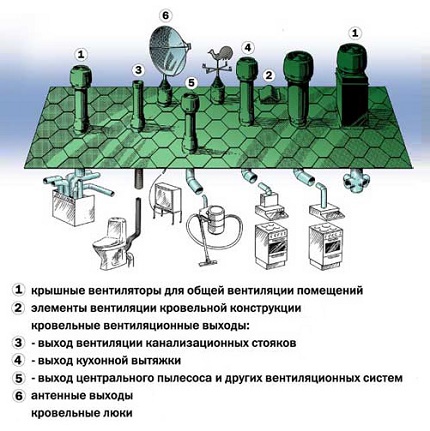
The absence of a thermal insulation layer contributes to the appearance of a temperature difference, which contributes to the formation of condensate on the surface of the ventilation pipes. Over time, this situation can lead to damage to the material of the structure, the formation of mold, oxides, rust, etc.
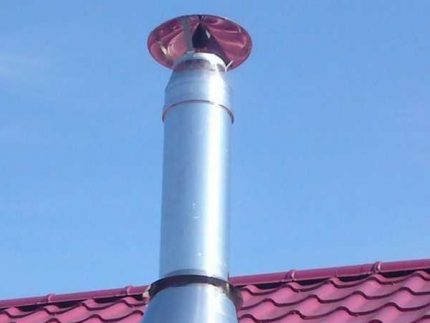
In old ventilation ducts, the so-called otter is usually provided - a thickening that allows the heated air to cool slightly before going to the roof. As a result, the difference in air temperature and roofing communications will be less, which will reduce the likelihood of condensation.
In modern houses, aprons are used, with the help of which the gap between the pipe and the roof is completely sealed. Cuts for installing aprons are formed with a grinder. Insulation of metal and plastic pipes can be done using mineral wool or other suitable material.
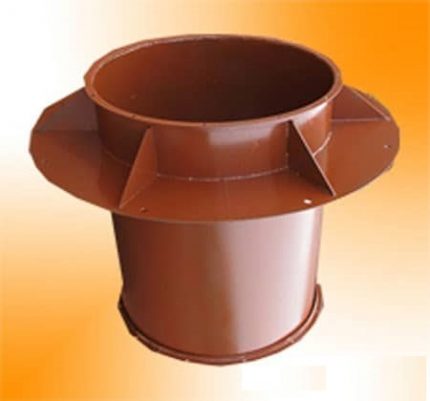
Sometimes for these purposes a wooden or metal box is used. Designing ventilation system, you should immediately consider the arrangement of the passage through the roof. Experts note that it is much easier to bring out a pipe with a rectangular or square section outward than a round construction.
To ensure a sufficiently tight fit of the ventilation pipe to the roof material, a square sleeve is usually used, which is worn on top of the pipe. It is filled with fireproof material, mainly sand or small expanded clay, which is why this design is called the “sandbox”.
It is necessary to remove ventilation above the roof to a height equal to the height chimney pipes. So you need to ensure stable traction. This value depends on the remoteness of the chimney from the ridge rib.
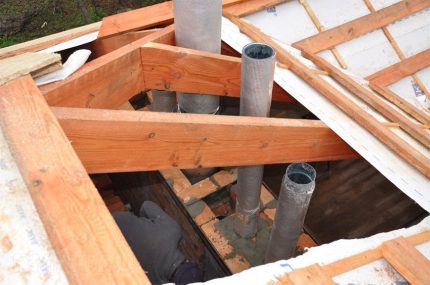
The passage unit must be securely fixed to all elements of the roof. Pay attention to the distance between the edge of the pipe and fixed above it. deflector. It should be so large that the air masses passing through the ventilation duct can move freely.
Hard roofing
To equip the node of the passage of the ventilation channel through the roof, covered with rigid roofing materials (tile, slate, corrugated board, etc.), a square construction such as a sandbox is used, the gaps around which are filled with non-combustible heat-insulating material.
It should be slightly flanged to protect the thermal insulation from contact with moisture directly on the pipe.Around a metal rectangular sleeve, it is necessary to install four parts of the apron, which ultimately cover the line of contact of the pipe to the roof from all sides.
First, the lower part is installed, then the side parts are mounted, after which you can put the apron element on top. The horizontal part of the part of the apron located above the rest should be placed under the roofing material. The rest, i.e. side and lower elements are mounted on top of the roof.
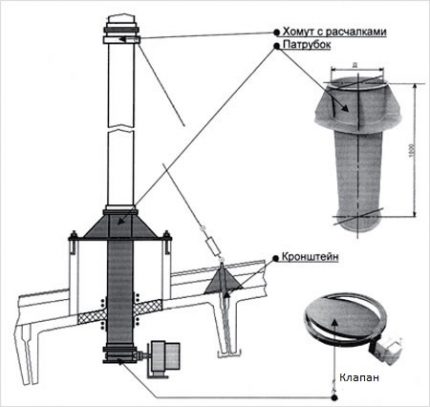
A tie is a long roof gutter, which should be provided for by a roof structure. Quite often, when installing the ventilation passage unit, it is possible to do without such an element. To clarify this point, it is recommended to consult an experienced roofer.
An apron can be purchased ready-made, but such a design is not difficult to make yourself. To do this, use galvanized roofing sheet with a thickness of 0.5 mm. It is undesirable to use a thicker roofing material, since it will be more difficult to bend to give the necessary shape.

But thin tin should not be taken for these purposes, since it does not have sufficient reliability. The size of the apron should correspond to the wave size of the material that is used for the roof.
For mounting the transition unit under the metal tile, the vertical part of the apron is made as two roofing waves in length, and the horizontal part is made in three times the wavelength.
These dimensions are designed to create a sufficiently large apron approach to the horizontal plane of the pipe and the inclined plane of the coating to prevent even accidental splashes under the roofing material. Aprons are also mounted with an overlap of the element mounted on top of the part located below.
An optimal overlap is considered to be equal to the width of one of them, but this position is not always achievable. So, the overlap of the upper and side elements of the apron will be hidden under the roof material, it is difficult to install the parts in the correct position.
But with the imposition of the lower and side parts of the apron, there is no such problem, it is recommended to accurately maintain the necessary dimensions. If necessary, the dimensions of the parts of the apron after installation can be adjusted using metal scissors.
Flanging should be done only for the top and side elements. For the bottom, such adjustment is not necessary, since moisture from it descends to the roof slope and, possibly, to the tie.
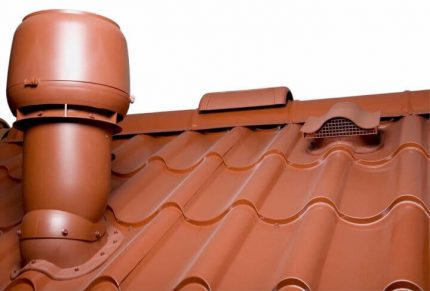
This element can be installed on top of the roof to optimize moisture removal. In such a situation, a slight bend towards the tie should be made on the lower part of the apron.
In addition, lower flanging is required. If the installation of a tie is not provided for by the design, then the lower flanging on the apron is not needed, but the release for moisture should be done more.
Arrangement of transition on a soft roof
Roof structures for soft roofs have some features that are reflected in the installation order of the ventilation passage. Slopes on such a roof are usually performed with a slope of 12º and above.
Piece roofing material is not suitable for arranging low-slope structures, as It features a large number of joints and seams. The arrangement of the passage unit in the pitched roof must be considered at the stage ventilation designto choose the best option.
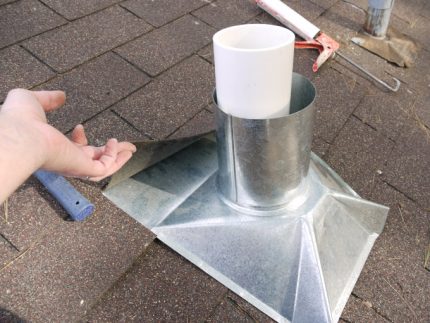
Before starting work on installing the ventilation passage, you should find out which side the roof is inclined to. If the passage unit is installed on a hard roof before the start of roofing, then in this situation, you must first roll out the main area of the roofing carpet.
After that, make a thermal unit and install heat-insulating materials. Further actions depend on the shape of the roofing node. For an element with a circular cross-section, it will be necessary to install only two parts, but the node of the square configuration is mounted using four components.
Instead of the hard aprons that were described above, here you will need segments of the surfaced roofing material. They are fixed on the roof and on the passage node. The fixing process begins from the bottom, then from the middle to the edges, after which the upper part of the lining is fixed.
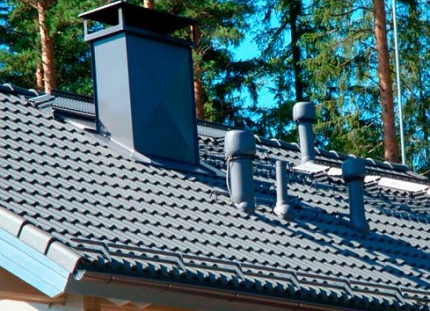
Separate elements are installed in this way: first the lower, then the side, complete the installation by securing the upper lining. Of course, all these details should have some overlap, but the requirements for its dimensions are not as stringent as when installing the passage under the hard roofing material.
From the pitched roof, streams of atmospheric water are diverted quickly and regularly, therefore, a significant overlap in this situation is not needed. But the low rate of winter rainfall on the roof can create another problem. At the joints, the roofing material may delaminate upon prolonged contact with moisture.

To prevent this situation, you should pay special attention to the quality of installation of a flexible roof, to accurately comply with all requirements of the installation technology. In simple terms, the roofing sheet should be properly heated and pressed securely. In this case, you can use the technique of slapping or use a special roller for rolling the shingle.
They slam the sheet with the help of a mitten in which a leather tab is embedded. The roller is more suitable for work on thin roofing materials. If a multilayer material is used, the installation of a large assembly is usually carried out using two-layer overlays.
For a small element, you can use only one layer. The round passage of small diameter is made out by two large plates with a horizontally bent “skirt”.
First mount the bottom element, then the upper one. During installation, the sheet of preheated material needs to be slightly tightened to ensure reliable coverage of ventilation communication and the necessary overlap.
Features of installation of a standard design
Nodes of penetration of ventilation communications of industrial production are performed in accordance with the requirements of GOST-15150. It is believed that the air temperature inside the communication pipe should not exceed 80 degrees, and the flow humidity should be within 60%.
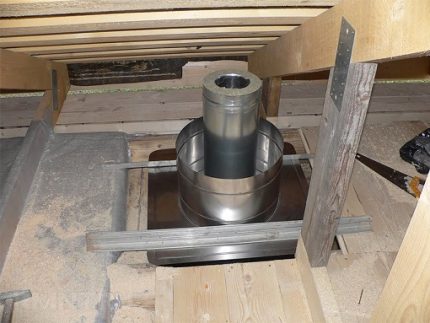
To calculate the passage assembly, indicators such as the slope angle of the ramp and the distance from the element to the roof ridge should be taken into account.
A typical transition node can be made in the following variations:
- with or without condensate ring;
- with insulated or conventional valve or without valve;
- with manual or mechanical control for the valve;
- with or without spark protection, etc.
The options listed may vary depending on the situation. For example, there is no need to install a mechanical valve if the system is stable and does not need constant adjustment. It is also possible to manufacture a site for custom drilling.
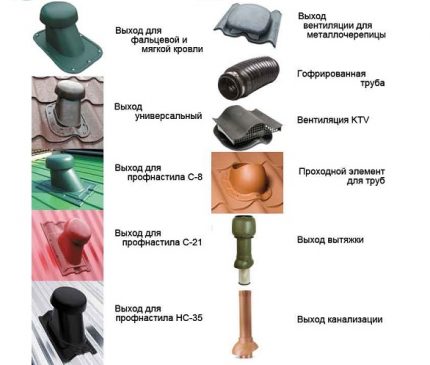
Designs of this type are made of polymers, stainless steel with a thickness of 0.5-0.8 mm and black steel 1.5-2 mm. The section of the finished transition node can be round, oval, square or rectangular. A specific model is selected depending on the type of roofing material and the parameters of the ventilation pipe.
Although the nodes of the passage of foreign production are usually of high quality, they are not always adapted for local climatic conditions, so it does not hurt to carefully study the proposals of domestic manufacturers.
They are usually labeled as follows:
- the letters UP with an index of 1 to 10 indicate a design without a condenser ring and valve;
- indices from 2 to 10 indicate devices with a manual valve, no ring;
- The designation UPZ is assigned to devices with a special platform for the actuator for the valve, which is provided for by the design.
In the complete set of ready-made models of transition nodes, there are embedded bolts and nuts that are attached to wooden structures, reinforced concrete glasses intended for installation. Mineral wool is successfully used for thermal insulation, which is recommended to be protected with a layer of fiberglass.
If it is necessary to install a ventilation unit with a protective valve, pay attention to the pipe intended for it. A valve must be attached to the bottom flange of this element. The upper flange is designed to fix the position of the duct. Clamps and brackets are used as fasteners for braces.
To further protect the ventilation riser from moisture, you must use a skirt. The condensate collector is welded to the pipe.
It is designed to remove moisture from air masses that move through the ventilation duct. To control the valve, a mechanical assembly is used, which should be installed on the shelf intended for it.
This element should not be installed near the condensate collection ring in order to maintain the integrity of all sinking elements. Typical models of nodes are usually mounted before the start of roofing works: first, the air ducts of the ventilation system are mounted, then the passage, and the roof is installed after that.
It is recommended that at the end of the work, all joints be sealed, including the junction of the site elements to the roofing.
To do this:
- clean the surface of the pipe and roof from contamination;
- glue the bottom of the duct and the adjacent portion of the roof with foil paper;
- fill the holes with a sealing compound.
These measures will help protect the penetration from moisture and create additional thermal insulation of the structure.
Recommended by us will familiarize you with the installation rules of the ventilation system directly article, which details the nuances of design and organization.
Conclusions and useful video on the topic
A video demonstrating the installation of the ventilation pipe passage through the roofing system allows you to get an idea of the features of this type of work:
Installing this important item is not too difficult to complete. But you need to strictly comply with the requirements of the installation technology to prevent moisture retention on the roof surface and its penetration under the coating.
Tell us about how you arranged the passage of the ventilation pipe through the attic and the roofing cake with your own hands. It is possible that you know the technological subtleties that will be useful to site visitors.Please write comments in the block below, post a photo and ask questions on the topic.

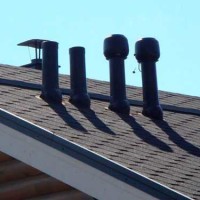 Adjoining the roof to the ventilation shaft: arrangement of the passage of the ventilation unit through the roof
Adjoining the roof to the ventilation shaft: arrangement of the passage of the ventilation unit through the roof 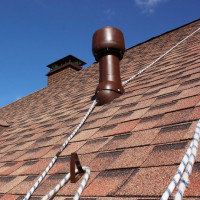 Ventilation on the roof of a private house: the construction of the passage of the duct through the roof
Ventilation on the roof of a private house: the construction of the passage of the duct through the roof 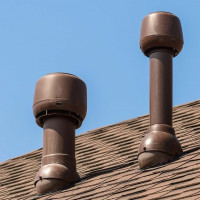 Ventilation pipes on the roof of the house: arrangement of the exhaust outlet through the roof
Ventilation pipes on the roof of the house: arrangement of the exhaust outlet through the roof 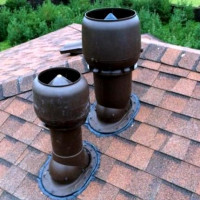 Ventilation pipes for the roof: tips for choosing a pipeline + installation instruction
Ventilation pipes for the roof: tips for choosing a pipeline + installation instruction  Arrangement of ventilation from sewer pipes: the construction of ducts from polymer products
Arrangement of ventilation from sewer pipes: the construction of ducts from polymer products 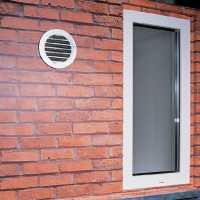 Exhaust ventilation through the wall to the street: installing the valve through an opening in the wall
Exhaust ventilation through the wall to the street: installing the valve through an opening in the wall  How much does it cost to connect gas to a private house: the price of organizing gas supply
How much does it cost to connect gas to a private house: the price of organizing gas supply  The best washing machines with dryer: model rating and customer tips
The best washing machines with dryer: model rating and customer tips  What is the color temperature of light and the nuances of choosing the temperature of the lamps to suit your needs
What is the color temperature of light and the nuances of choosing the temperature of the lamps to suit your needs  Replacement of a geyser in an apartment: replacement paperwork + basic norms and requirements
Replacement of a geyser in an apartment: replacement paperwork + basic norms and requirements
From my own experience I’ll say that it’s not difficult to arrange proper ventilation in your home. But when I put down the pipe and brought it out onto the street, after sealing the passage through the roof, there was no effect. The neighbor advised to increase the length of the pipe as much as possible. I thought and realized that his statement was wrong. I began to search for literature on this issue. Found this information. Everything in it is detailed and phased. I began to do, focusing on the description. No enlargement of the pipe was required. Thoroughly sealed, installed a fan. Everything has become normal. That's what a smart recommendation means.
I have the roof of their wave slate. Therefore, sealing the ventilation pipe is a big problem. Actually, still some leaks are periodically detected. Maybe someone will tell you a 100% way, if one exists. And another problem in winter is the large amount of snow on the roof. It’s necessary to clean off closer to spring, otherwise I’m afraid I’ll break the pipe with the falling snow.